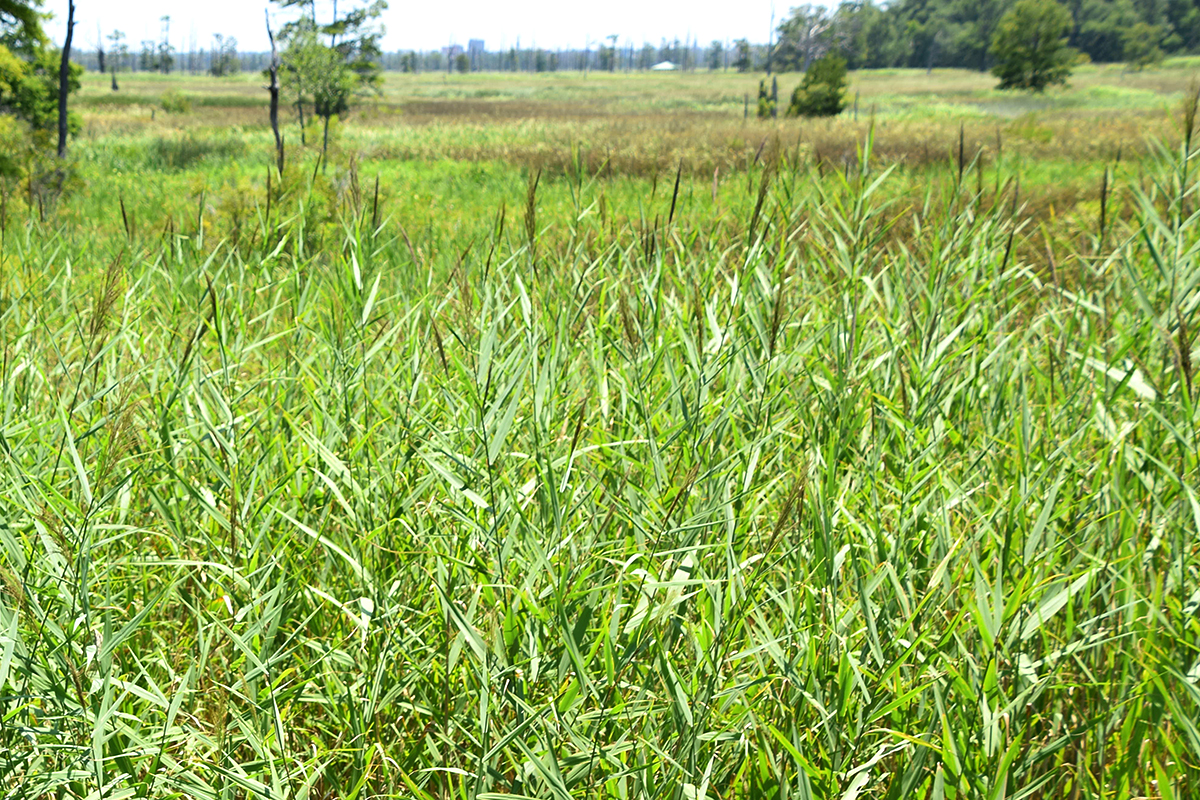
A tall and looming reed grass, nonnative phragmites now extends pervasively into North Carolina’s marshes and shorelines.
Likely introduced to North America in the 18th or 19th century, it hasn’t taken long for Phragmites australis — more commonly known as phragmites or even casually referred to as “phrag” — to thoroughly establish its foothold in the U.S.
Supporter Spotlight
Phragmites has a tendency to take over wetlands, pushing out native marsh grasses. The toll of its dominance is significant. It can negatively impact the biodiversity of an area, and endanger other species that depend on native habitats. A leading example is the diamondback terrapin, a turtle native to tidal marshes in the eastern U.S. When phragmites encroaches their habitat, it becomes harder to find places to nest and lay eggs.

Phragmites has been studied for decades. Many people try to get rid of it, but eradication is not easy, said Tracy Skrabal, coastal scientist with the North Carolina Coastal Federation in Wrightsville Beach. The Coastal Federation publishes Coastal Review.
“It’s difficult to eradicate it,” Skrabal said. “The traditional techniques for eradicating involve using some pretty nasty chemicals.”
In Skrabal’s past work addressing phragmites, she had some success with the eradication approach in a small, isolated patch. If you catch it early, you may get rid of it. But once it has taken hold, you are likely out of luck. The success rate of long-term eradication attempts is low. Continued — and often costly — action is needed to keep phragmites away once it has become established.
The chemicals used in eradication have been tied to adverse effects on ecosystems and human health.
Supporter Spotlight
In the last several years, the phragmites discourse has started to evolve in a way that takes climate change into consideration more than before. A new wave of research has indicated that, while there are significant perils associated with phragmites, the reed can also help ecosystems adapt to some of the effects of climate change. This complicates the equation.
“As a scientist, it is not clear cut,” Skrabal said.
Potential benefits include protection against erosion due to phragmites’ extensive root systems, and effective carbon sequestration – the storage of atmospheric carbon dioxide. Both are things that make an environment more resilient to climate change.
In 2017, the Coastal Federation hosted a workshop about phragmites, bringing together leading researchers and managers from across the country to speak on the issue. The intention was to more comprehensively understand the plant and its effects on the ecosystem and discuss management options.
More recently, the National Oceanic and Atmospheric Administration held several webinars about phragmites, with numerous researchers explaining the multiple facets of the phragmites issue.

Mollie Yacano is a doctoral candidate at the University of North Carolina Institute of Marine Sciences based in Morehead City, and she was one of the presenters during the NOAA seminar series. Her research, which was recently published in Estuaries and Coasts, looks at the nitrogen removal capacity of microbes in the soil beneath phragmites in comparison to native grasses in salt marshes.
Salt marshes around the world can be responsible for removing or retaining between 20% and 50% of excess nitrogen. This is a very valuable service, because nitrogen pollution contributes to algal blooms and fish kills.
Yacano found that in her marine tidal marsh study areas, phragmites were better at denitrification than native grasses. In the brackish marsh study areas, all grasses performed equally. What this means is that, in this context, phragmites is just as good or better at denitrification than native grasses.
“So even that, when you’re thinking about it big picture,” Yacano said. “Is it worth killing this plant?”
This makes phragmites management complicated. It is impossible to overlook the downsides of phragmites, but it is becoming equally important to recognize its potential value, especially as marsh ecosystems are threatened by factors associated with climate change.
On the positive side, researchers like Yacano may be able to help inform management practices moving forward.
“I think one of the really cool things (about) being part of that NOAA group was seeing how many other people are interested in trying to understand how we can use all of this different research to put together resources on best management practices,” Yacano said. “How can we understand better what we’re doing, and then make decisions better based on that.”







